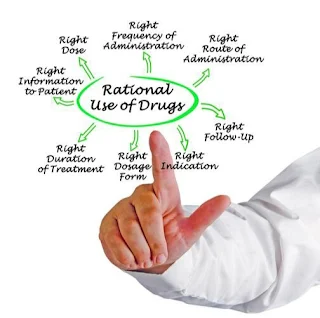Rational Drug Use and Prescription Audit
RATIONAL DRUG USE & PRESCRIPTION AUDIT
Description also available in video format (attached below), for better experience use your desktop.
Rational Drug Use
· Introduction
o RDU can be defined as the usage of appropriate drug with
§ Proven safety
§ Proven efficacy
§ For the right patient
§ In the appropriate dose and dosage form
§ In proper intervals of time
§ At low cost
·
Criteria for using medicines
o Appropriate indications
o Appropriate drug
o Affordable
o Appropriate administration, dosage & duration
o Appropriate patient
o Appropriate patient information
·
Obstacles in RDU
o Prescriber may obtain some financial benefits in
prescribing more drugs
o Pharmacist may also promote irrational drug use to
enhance his sales
o Easy availability of schedule H drugs (Habitual forming
drugs like cocaine)
o No proper training and continues education to the
prescriber
o Wrong notion among common man that every ill has a pill
·
Measure to promote RDU
o Educational
measures
§ Training of prescriber
§ Printed material
§ Patient education
o Regulatory measures
§ Medicine registration
§ Limited medicines list
§ Prescribing restrictions
§ Dispensing restrictions
o Managerial measures
§ Monitoring Supervising
§ Feedback
§ Selection of medicines
§ Procurement of medicines
§ Distribution of medicines
§ Prescribing & dispensing approaches
Prescription
Audit
·
Introduction
o
Prescription is a
paper on which a doctor has written the name of the medicine that you need
o
Patients takes their prescription to the
pharmacist and get their medicines
o
Audit is the evaluation
of data, documents and resources to check the performance of the system to meet
some standards
·
Steps
o
Defining standards
o
Collecting data
o
Identifying areas for improvement
o
Making necessary changes
o
Background for defining new standards
·
Process
o
Randomly selected the prescriptions
o
In prescription check all the parameters of
audit as per the checklist
o
Fill the prescription audit checklist
o
Submit the report to the department and
quality committee
·
Parameters
o
Name of patient
o
Age
o
OPD number
o
Dose of drug
o
Dosage of drug
o
Route of drug administration
o
Frequency of drug administration
o
Date
o
Legible
o
Known allergy documented
o
Drug interactions, if any
o
Food drug interactions, if any
o
Signature of the doctor
o
Percentage (%) of
§ Medicines prescribed by generic name
§ Encounters with an antibiotic prescribed
§ Encounters with an injection prescribed
§ Medicines prescribed which are from essential medicines
list or formulary list
§ Medicines actually dispensed
§ Medicines that actually labelled
§ Patient who know how to take their medicines
·
Benefits
o
Provide background information for decision
on formulation of National essential list of medicine (NLEM)
o
Promote working with multidisciplinary teams
o
Resource allocation to provide better patient
care
o
Improve professional practice and quality
standards
o
Identify & eliminate wastage
Video
Description
·
Don’t forget to do
these things if you get benefitted from this article
o
Visit our Let’s
contribute page https://keedainformation.blogspot.com/p/lets-contribute.html
o
Follow our page
o
Like & comment
on our post
·





Comments